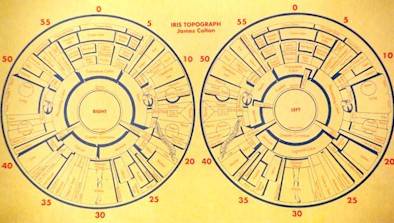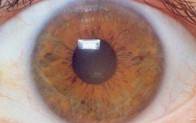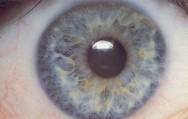Positive Health Online
Your Country

Iridology
listed in vision and eye sight, originally published in issue 23 - November 1997
Have you ever wondered why some people never get ill, yet others take to their bed for a fortnight with a cold? We probably all know of someone who does everything they should not do for good health, yet stays relatively well. While others desperately try to eat well, jog and have positive thoughts, but succumb to every bug going around.

Ignacz von Peczely
Iridology can help you understand what 'optimum health' means for an individual person. The iris (the coloured part of the eye) displays a unique insight into our health potential and disease dispositions. Iris patterns and pigmentation reveal the history of our inherited health.
Iridology is the study of the iris as associated with disease.[1] Hippocrates, the Father of Medicine first described it, and it was rediscovered in 1860 by Ignacz von Peczely (see photo left) who devoted his life to its study.

Figure 2 The British Iris Chart
Peczely's Owl
Like many enchanting stories, the truth has probably been distorted over the years, but it still has appeal today: as a boy, Ignacz caught an owl and accidentally broke its leg. While he bandaged its leg he noticed a small white cloud in the owl's iris. He was beside himself at his clumsiness and nursed it back to health with care. As the owl improved, Ignacz watched the white cloud become a black speck.
They became great friends and even when fully recovered the owl did not leave Ignacz. He was fascinated with his pet's eyes and observed the black speck disappear, leaving just a white line.
This encounter led Peczely to become a great physician of his time. He published several books on Iridology and gained much notoriety, but was limited in his observations of the iris, because of the optical equipment available to him. Now we have sophisticated cameras and microscopes with powerful magnifying capabilities. This helps enormously when identifying individual nerve fibres and tiny iris markings.
Iris Colour
The eye's colour alone reveals a great deal of positive information.
There are only three basic iris colours: blue, brown and a mixture of the two, appropriately called 'mixed'. All irises can be placed in one of these colour groups. Green eyes do not really exist as the green appearance of the iris is usually due to discolouration or yellow patches in a blue or mixed colour iris. The effect of which are shades of blue from the iris shown through yellow discolouration. Mixing blue and yellow produces green. Although every iris is different, we generalise them according to colour with regard to health and disease probabilities.
About thirty years ago, Morgan Worthy of Georgia State University documented that athletic performance could be directly linked to iris colour. He found that sports relying on split-second timing, like boxing, were better performed by brown-eyed people. But in self-pacing sports like golf, blue-eyed people were superior. Athletic surveys have confirmed these findings and they are not confined to race. In Eye Colour, Sex and Children Behaviour[2] Gary and Glover claim that blue-eyed bowlers earn more money than those with brown-eyes; but brown-eyed people are more skilful at hitting a baseball flying towards them at great speed.
Brown-eyed people have a faster reflex than those with blue eyes. Experiments show that the darker the eye, the faster your reflexes are. Peter Post of New York Hospital clinically tested reflex action by electronically dropping a ruler, accompanied by a buzzer or flash of light. Volunteers had to catch the ruler as it fell. Variables such as gender, age, etc. were taken into account, but the results showed that the darker the iris, the faster your reflexes. Brown-eyed people consistently caught the ruler more times than blue-eyed people.
This work has helped Iridologists understand the nature of their patients, and has highlighted the differences from one iris colour to another.
Blue Iris: called Lymphatic has a random iris structure, appearing bluer towards the outer edge. Young people with blue eyes tend to have sinus, throat and breathing problems, such as asthma. In later life rheumatism and arthritis are frequent. The lymph system of the body is often overloaded and this is a good reason why lymph drainage massage works well for people with blue eyes. The kidneys can be sluggish and this may lead to water retention.
Brown Iris: called Haematogenic, is very densely pigmented and on close inspection resembles a velvet carpet. Very few individual fibres can be seen, viewing through a bio-microscope makes it easier. People with deep brown eyes usually need more vitamins and minerals in their diet. This genetically low mineral status often leads to glandular disturbances. Blood and circulation disorders are associated with this iris type and may cause problems such as anaemia.
Mixed Iris: called Biliary, (see Figure 3) may appear as hazel or green eyes. This category is a genetic mix of both blue and brown, over many generations. The iris may appear with patches of blue and brown in its fibres. This group often suffers from digestive disorders, particularly connected to the liver and gall bladder function. Fluctuations in blood sugars may cause hypoglycaemia, with its symptoms of sudden, extreme tiredness, chocolate cravings and mood swings, among others.
From just colour alone, the iris reveals much information. But the eye is a complex structure, a web of delicate fibres forming a unique pattern of lacuna, defects, pigment spots and other iris markings. It is this individual pattern that is studied by an iridologist. Not only the particular type of structure marking is noted, but also its location on the iris chart is important to establish the iris/body connection.

Figure 3 Biliary Iris

Figure 4 Blue Iris showing generic differences
The Iris Chart
From a simple diagram, (see Figure 2) the iris chart has developed into a complex chart placing most bodily organs in their relative anatomical position. For analysis purposes the chart is divided into sections like the minutes of a clock face, 60' being at the top of the chart and 30' at the bottom.
Historically, Peczely began its development in Hungary, later other parts of Europe, mainly Germany extended the iris connection to the body. In America, Jensen, took the German model and popularised it between 1950 and 1960, and in doing so much of its accuracy was lost. This was mainly due to the legal position of American Iridologists as they were unable to practice freely. So the practical application of the iris chart was restricted.
The chart used most widely today is the British chart and is a further development of the original European model. Not only British and European Iridologists use this popular chart, but further afield too. Research by Blue Rose, a Taiwanese complementary organisation, tested the British Chart against others. They reported that it consistently produced the most accurate results and now it is widely used in their medical teaching courses.
Markings seen in the iris are located on the iris chart to determine their bodily influence. For example, a lacuna (an oval shaped structural marking) seen at 30' indicates that a genetic weakness has been passed to the kidney.
Much of the early work on iris topography was carried out at post-mortem. By studying the eyes of people who had died from a certain disease at post-mortem, early pioneers began to build up an iris 'map'. For example, Peczely worked in the surgical ward of his college hospital and had access to people before and after death. He observed that patients who died from kidney disease all had a similar marking – in the same area of their iris, at 30'.
Genetic Influence
Although much of iridology's evidence is anecdotal, it is powerful evidence (see Figure 4). When the iris displays a genetic influence in a particular zone, there is, or will be a problem with the function or performance of that organ. Even if the disease has gone from the body, the genetic influence will always remain. A person, who has a genetic iris heart marking and subsequently has a heart attack, may fully recover from his illness, but the weakness will still be there. He will always carry the inheritance to this weakness and to stay healthy, should live his life within his health capabilities. Iridology can reveal individual health levels and suggest ways of adapting your life to suit your genetic needs. A heart lacuna may show a genetic influence, but by monitoring diet and lifestyle and other external stimuli, any heart disease may be postponed for many years
Orthodox research into genetic markers is progressing at breathtaking speed and being introduced into clinical practice almost immediately. At any time thirteen per cent of us are 'at risk' of having a heart attack. But from here the group gets smaller and the odds increase dramatically. The risk of heart attack is greater for overweight smokers who have Low-density Lipoproteins (LDL). In the same way, there is a group of people who have a very low risk of heart attack because of their genetic inheritance.
When 'Linda' came to see me for an Iridology consultation, she was already convinced that she had a heart problem, even though she was only 22 years old. Her G.P. had dismissed her as being a neurotic, new mother, but she was very worried. Her iris revealed a lacuna in the heart zone and I explained about her genetic iris influence. Far from being more frightened she was relieved that her symptoms were not 'in the mind'. I wrote to her G.P. sharing my iris findings, and, when further tests were carried out, it was found that 'Linda' had a genetically faulty heart valve.
Why Consult an Iridologist?
A Chinese proverb says: 'A poor doctor cures; a good doctor prevents'. Iridology takes this to heart. All medicine longs to prevent a disease or disorder from occurring, any type of doctor would agree that it is easier, and more cost effective to nip disease in the bud.
Iridology is ideally suited to prevention in the true sense. We all have genetic weaknesses of some type or another, if we were perfect we would be super-beings, not human. The skilled Iridologist pinpoints inherently weakened organs or glands that may not yet be producing symptoms or even discomfort. By studying the iris markers the iridologist can then offer suggestions on how to avoid a disease or dysfunction occurring. By identifying the external stimuli, that trigger the weakness to manifest itself, symptoms of disease may be avoided, or at least, delayed. This can be clarified by iridology's simple formula:
Genetic Weakness + External Stimuli = Symptom (GW+ES=S)
By carefully observing dietary intake, lifestyle, habits and environment, the Iridologist can identify irritants to an individual's health.
Living within the personal limitations of genetic inheritance may be the best way of achieving longevity. Human beings are immensely diverse and adaptable to their environment. If we recognise and identify any weaknesses that we may have, we are better able to avoid an external stimulus that would cause disease.
For example, a person may smoke twenty cigarettes a day and live to a ripe old age – providing he does not have a genetic weakness that involves smoking. Conversely, a person may never smoke, yet develop lung cancer if he has a genetic lung marker.
Iridology and Blood Groups
Complementary medicine has often maintained that our health depends on what we eat, but new evidence shows that our genetic inheritance and even our blood group offer new insights into our health potential.
Brown-eyed people with blood group O secrete more stomach acids than blue-eyed people with blood group A. Such people who show stomach and bowel iris marking may be healthier with some meat in their diet. So a brown-eyed vegetarian may believe that he or she is on the right dietary track, but in fact, may be better off introducing white meat into their diet two or three times a week. Blood group O evolved from hunter-gatherers and demands a high protein intake. They have a higher incidence of gastric ulcers than the other blood groups. An Iridologist could pick up any inherent ulcer site weakness.
Vegetarianism is best suited to blue-eyed people with blood group A. This blood group is thought to have emerged from agricultural practices. Therefore a person who fits this category, and who shows iris marking in the stomach zone, may be advised to stop eating meat. Daily protein should be taken from legumes and vegetable sources. This is of course a little over-simplified, and an Iridologist would take other factors into account.
People with blood group B are healthier on diets containing fish and dairy foods and are usually blue-eyed. They tend to have a higher incidence of bladder and kidney diseases. The iris can pinpoint potential bladder kidney weaknesses and therefore help prevent disease from developing.
D'Adamo and Powers have called blood group AB the 'modern diet' blood type, as they can tolerate small amounts of most foods. Sea food, nuts and grains are tolerated well although they may also combine characteristics of the other two groups.
Stress
Stress is a much talked about subject, yet not many therapists take their patients' genetic stress into account. Some people actually need stress to function properly. For others even a simple problem can lead to physical breakdown. The iris shows stress very well. It can be easily identified by the presence (or absence) of stress rings and other specific iris markers. People who display stress rings in their iris have a skittish, nervous disposition. But this does not mean that they live waiting for a nervous breakdown. Stress can be a positive inspiration, if we had no stress at all many of us would not get out of bed in the mornings. People with stress rings often work harder, more effectively and achieve more, they are also sensitive to their surroundings. They need a higher than average intake of B complex vitamins to maintain their health.
Registered Iridologists (R.Ir.)
When visiting an Iridologist you will want to know he or she is properly trained and qualified. Every qualified Iridologist uses the initials, R.Ir. after their name. This shows they have undergone at least one years' training and passed an examination. A Registered Iridologist will conduct the iris diagnosis before any case history is taken from you. A 6x iris loupe and pen torch will be used to examine both eyes, although many Iridologists are upgrading to iris microscopes which are now widely available.
Conclusion
Iridology is a safe, non-interventionary diagnostic technique, it requires no needles, and no anaesthetic or drugs. Yet it may provide a valuable guide to health and disease. If every doctor's surgery employed a trained Iridologist and diagnostician many exploratory operations would be avoided. This would save, not only financial revenue, but time and suffering on the part of the patient.
Iridology is probably ahead of its time at the moment. It takes a special and futuristic practitioner to employ iridology to its full advantage. But in the future Iridology is set to establish itself as a mainstream diagnostic technique into the twenty-first century.
References
1 Bailliere's Encyclopaedic Dictionary of Nursing and Health Care. 1989
2 Gary and Glover Eye Colour, Sex and Children Behaviour 1976
Comments:
-
No Article Comments available